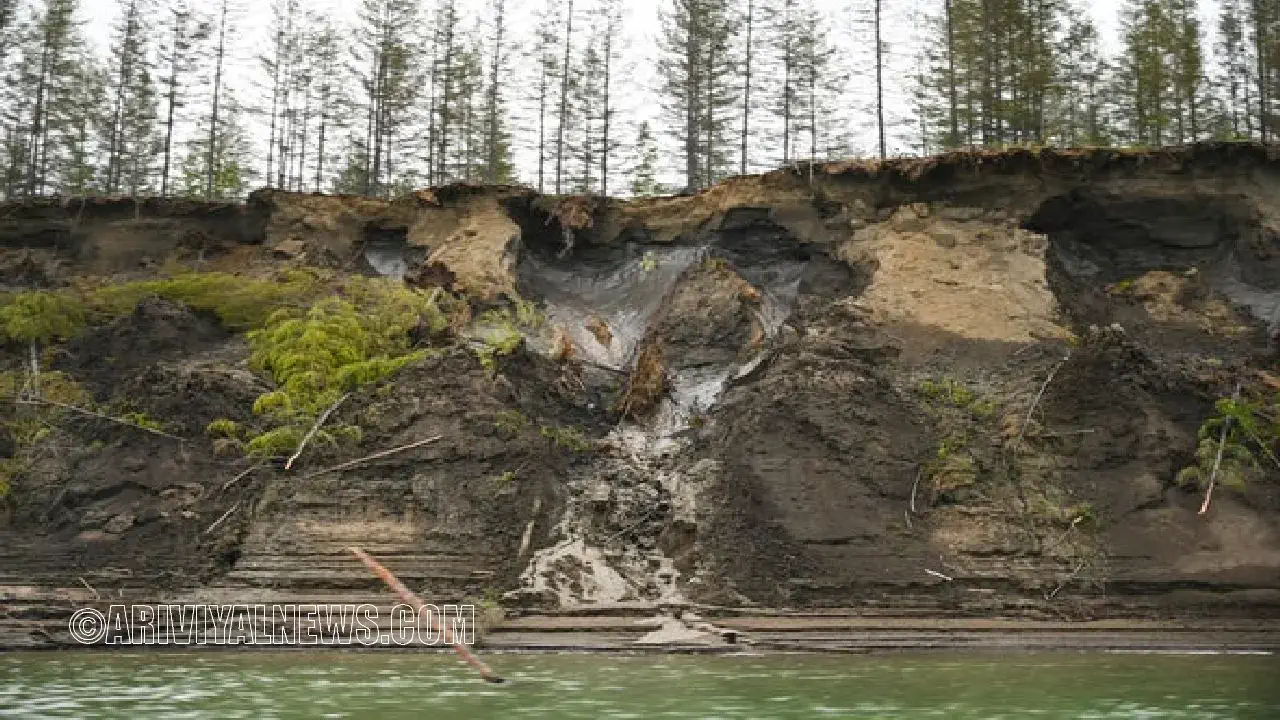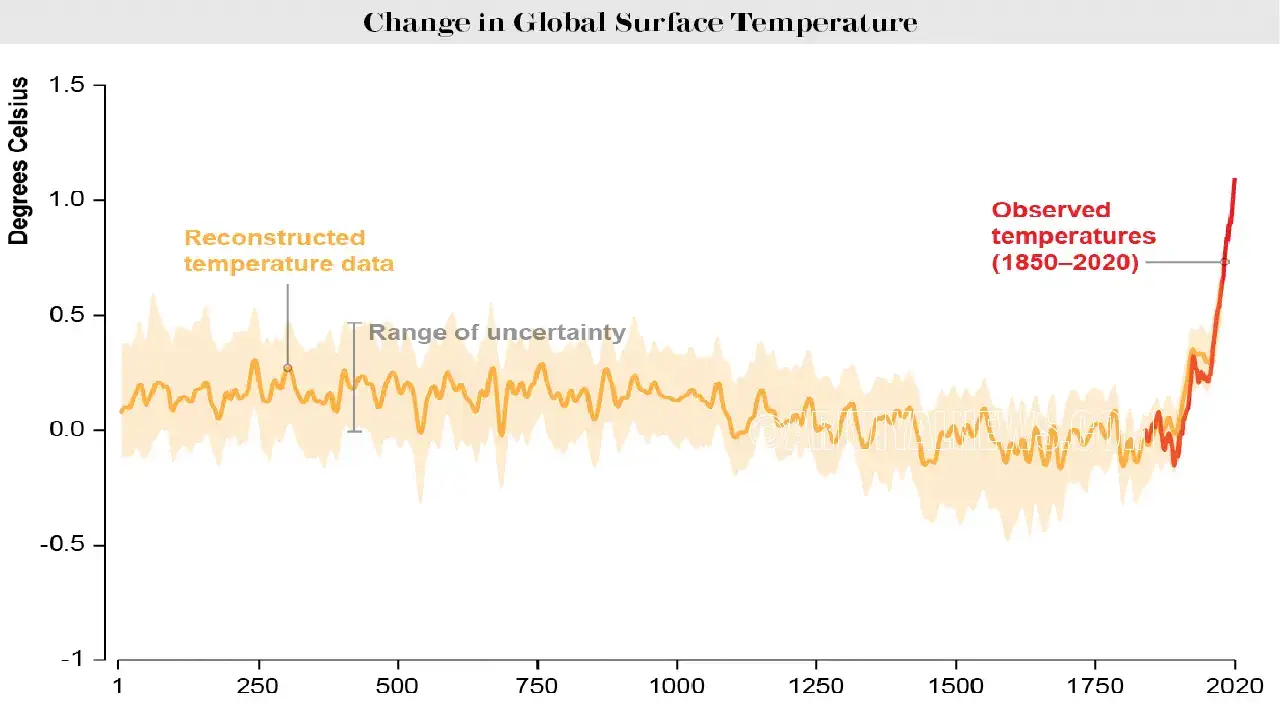
காலநிலை மாற்றம் குறித்த புதிய அரசாங்கங்களுக்கிடையிலான குழு தற்போதைய வெப்பமயமாதலை நன்கு புரிந்துகொள்ள நமது கிரகத்தின் தொலைதூர கடந்த காலத்திலிருந்து தரவைப் பயன்படுத்துகிறது
இந்த வார காலநிலை மாற்றங்களுக்கிடையேயான காலநிலை மாற்றம் குறித்த சர்வதேச அரசு குழு அறிக்கையில் (ஐபிசிசி) அறிக்கையின் தேடலானது அறிவியலின் சிறப்பியல்பு எச்சரிக்கை மொழியைக் கருத்தில் கொண்டு குறிப்பாக அச்சமூட்டுகிறது. ஆவணத்தின் 234 ஆசிரியர்களின் முதல் ஒருமித்த கருத்து: புதைபடிவ எரிபொருட்களை மனிதகுலம் எரிப்பது காலநிலை மாற்றத்தை ஏற்படுத்தியது என்பது “தெளிவற்றது”. உண்மையில், அறிக்கையில் உள்ள தரவு புனரமைப்புகள் பூமியின் சராசரி மேற்பரப்பு வெப்பநிலை சுமார் 125,000 ஆண்டுகளில் நீண்ட காலமாக இந்த வெப்பமாக இல்லை என்பதைக் குறிக்கிறது
சமீபத்திய ஐபிசிசி அறிக்கை பசுமை இல்ல வாயு வெளியேற்றத்தின் விளைவுகளை விவரிப்பதில் எந்தவிதமான குத்துகளையும் இழுக்கவில்லை என்று ஜார்ஜியா இன்ஸ்டிடியூட் ஆப் டெக்னாலஜியின் காலநிலை விஞ்ஞானி மற்றும் மதிப்பீட்டின் முன்னணி எழுத்தாளர்களில் ஒருவரான கிம் காப் பத்திரிகையாளர்களுக்கான முன் வெளியீட்டில் குறிப்பிட்டார். கடந்த ஐபிசிசி அறிக்கைகளை விட அதிக உறுதியுடன், கோப் மற்றும் அவளுடைய இணை ஆசிரியர்கள் பருவநிலை மாற்றம் ஏற்கனவே உலகெங்கிலும் கடுமையான வெப்ப அலைகள், வறட்சிகள், கனமழைகள் மற்றும் வெப்பமண்டல சூறாவளிகளை உந்துகிறது என்று முடிவு செய்கின்றனர். ஆய்வு செய்யக்கூடிய அனைத்து உமிழ்வு காட்சிகளிலும், குறைந்தபட்சம் 2050 வரை வெப்பநிலை உயரும் மற்றும் 2040 க்குள் 1.5 டிகிரி செல்சியஸை விட அதிகமாக இருக்கும். ஆனால் 2050 க்குள் உமிழ்வு நிகர பூஜ்ஜியத்திற்கு கொண்டு வரப்பட்டால் – அதாவது, வெளியிடப்பட்ட கிரீன்ஹவுஸ் வாயுக்கள் அகற்றப்பட்ட அளவுகளால் சமப்படுத்தப்படுகின்றன. வளிமண்டலம் – இந்த நூற்றாண்டின் போது வெப்பமயமாதல் இன்னும் 1.5 டிகிரி செல்சியஸாக மட்டுப்படுத்தப்படலாம்.
14,000 க்கும் மேற்பட்ட ஆய்வுகளை மேற்கோள் காட்டும் ஏறக்குறைய 4,000 பக்க ஆவணம், 2013 க்குப் பிறகு ஐபிசிசியின் காலநிலை அறிவியலின் நிலை பற்றிய முதல் முக்கிய மதிப்பீடு ஆகும். அறிக்கையின் உறுதியானது பூமியின் காலநிலை அமைப்பைப் பற்றி நன்கு புரிந்துகொள்வது மட்டுமல்லாமல் அதன் மீதான விசாரணைகளையும் அடிப்படையாகக் கொண்டது. காலநிலை கடந்த காலம். பவளப்பாறைகள், மர வளையங்கள், பனி அல்லது கடல் வண்டல்களில் இருந்து பிரித்தெடுக்கப்பட்ட கோர்கள் மற்றும் பிற ஆதாரங்கள், கோப் போன்ற பேலியோக்ளிமேட் ஆராய்ச்சியாளர்களை நவீன பதிவுகளுக்கு அப்பால் மற்றும் பண்டைய உலகங்களுக்குள் பார்க்க அனுமதிக்கிறது, இது காலநிலை அறிவியல் மற்றும் கணிப்புகளுக்கான முக்கியமான நுண்ணறிவுகளை உருவாக்குகிறது. ஐபிசிசியின் புதிய அறிக்கையை செம்மைப்படுத்துவதில் பேலியோக்ளைமேட் தரவின் பங்கு மற்றும் பூமியின் தற்போதைய வெப்பமயமாதலுக்கான சூழலை வழங்குவதன் முக்கியத்துவம் பற்றி அறிவியல் அமெரிக்கர் கோப் உடன் பேசினார்.
நமது காலநிலை கடந்த காலத்தைப் பார்ப்பது ஏன் முக்கியம்?
கருவி அளவீடுகளிலிருந்து காலநிலை பதிவுகள் பெரும்பாலும் 50 வருடங்கள் பின்னோக்கி செல்கின்றன – சில நேரங்களில் 100 அல்லது 150 இருக்கலாம் – பூமியின் காலநிலை அமைப்பில் இயற்கையான மாறுபாட்டின் முழு அகலத்தையும் நம்மால் உண்மையில் பிடிக்க முடியாது. பேலியோக்ளைமேட் காப்பகங்களுடன் நாம் என்ன செய்ய முடியும் என்பது அந்த பதிவை காலத்திற்கு நீட்டிக்கிறது. பெரிய அளவிலான சராசரிகளை உருவாக்க இப்போது உலகின் பல தளங்களில் எங்களிடம் போதுமான பதிவுகள் உள்ளன-இது கிரகம் முழுவதும் இன்று என்ன நடக்கிறது என்பதை நேரடியாக ஒப்பிட்டுப் பார்க்க அனுமதிக்கிறது. இன்று எவ்வளவு விரைவாக விஷயங்கள் மாறுகின்றன, இது எவ்வளவு அசாதாரணமானது என்பதற்கு அந்த சூழலை வழங்குவது முக்கியம்.
இந்த புதிய அறிக்கையில் பேலியோக்ளைமேட் ஆராய்ச்சி எவ்வாறு பயன்படுத்தப்பட்டது?
1990 ஆம் ஆண்டில் முதல் ஐபிசிசி மதிப்பீட்டின் ஒரு பகுதியாக பேலியோக்ளைமேட் ஆராய்ச்சி உள்ளது. இங்குள்ள வித்தியாசம் என்னவென்றால், அதன் சொந்த அத்தியாயத்திற்கு தள்ளப்படுவதற்கு பதிலாக, அறிக்கையின் ஒவ்வொரு அம்சத்திலும் இந்த ஆதாரங்களை ஒருங்கிணைக்கும் முயற்சி உள்ளது. ஒவ்வொரு துறையிலும் உள்ள காலநிலை விஞ்ஞானிகள் இப்போது பேலியோக்ளைமேட் மூலங்களிலிருந்து கிடைக்கும் தகவல்களின் செழுமையைப் புரிந்துகொள்கிறார்கள். தற்போதைய தட்பவெப்ப மாற்றம் குறித்த ஆய்வுகளில் மிகவும் பொதுவான அளவு பகுப்பாய்வுகளுக்கு அளிக்கும் அளவு தகவல்களை வழங்க இந்த தளம் சமீபத்திய தசாப்தங்களில் முதிர்ச்சியடைந்துள்ளது.
இன்று நாம் காணும் காலநிலை மாற்றங்களுக்கான புவியியல் பதிவில் ஏதேனும் முன்னுதாரணங்கள் உள்ளதா?
சுமார் 125,000 ஆண்டுகளுக்கு முன்பு, கடந்த இண்டர்கிளாசியல் காலத்தில் ஒரு நேரத்தைப் பார்ப்பது சுவாரஸ்யமானது. அந்த இடைவெளியில் வெப்பநிலை அதிகரிப்பு பற்றிய நமது சிறந்த மதிப்பீடுகள் ஒன்று முதல் இரண்டு டிகிரி செல்சியஸ் வரை இருக்கும் – நாம் இன்று நிறுத்தி வைக்கப்பட்ட இடத்தைப் போலல்லாமல், பூர்வ பூர்வ காலத்தை விட ஏறக்குறைய ஒரு டிகிரி சி வெப்பம். அப்போது, சூரியனைப் பொறுத்து பூமியின் சுற்றுப்பாதையில் ஏற்பட்ட மாற்றங்களால் இந்த அதிகரிப்புகள் உந்தப்பட்டன, மேலும் கிரீன்லாந்து பனிக்கட்டி உருகுவதை வெப்பமயமாக்க பல ஆயிரக்கணக்கான ஆண்டுகளாக நீடித்தது. இந்த எண்கள் நமது கிரகம் மிக தொலைவில் இல்லாத புவியியல் கடந்த காலத்தில் இருந்தது மற்றும் நாம் ஏற்கனவே இருக்கும் வெப்பமயமாதல் நிலைகளுக்கு பூமி முழுமையாக பதிலளிப்பதால் நீண்ட காலத்திற்கு நாம் எங்கு செல்கிறோம் என்பதற்கான பெரிய ஆச்சரியக்குறியாகும்.
எவ்வாறாயினும், பூமியின் கடந்த கால சூடான காலங்கள் எதுவும் நாம் இன்று பார்ப்பதற்கு பொருத்தமான ஒப்புமை அல்ல. நாம் இப்போது மேற்கொள்ளும் விகிதங்கள் தற்போதைய காலநிலை மாற்றத்தை இந்த அளவு கடந்த கால மாற்றங்களிலிருந்து மிக நீண்ட கால அளவுகளில் நடந்த மற்றும் இயற்கை காலநிலை இயக்கிகளால் ஏற்படுத்துவதை வேறுபடுத்தி காட்டுகின்றன.
இந்த அறிக்கையில் காலநிலை உணர்திறன் எனப்படும் ஒரு முக்கியமான அளவீட்டுக்கான புதிய மதிப்பீடுகள் உள்ளன. அது என்ன, அதை மதிப்பீடு செய்ய பேலியோக்ளைமேட் ஆய்வுகள் எவ்வாறு உதவியது?



காலநிலை உணர்திறன் என்பது வளிமண்டலத்தில் கார்பன் டை ஆக்சைடு அதிகரிக்கும் ஒரு யூனிட்டுக்கு எவ்வளவு வெப்பமயமாதல் ஏற்படுகிறது. அதிக காலநிலை உணர்திறன் என்பது கொடுக்கப்பட்ட CO2 அதிகரிப்புக்கு அதிக வெப்பமடைதல் மற்றும் நேர்மாறாக. இது எதிர்கால உமிழ்வு பாதிப்புகளின் நிச்சயமற்ற ஒன்றாகும், ஆனால் இந்த அறிக்கை கடந்த அறிக்கைகளுடன் ஒப்பிடுகையில் அதன் வரம்பை கணிசமாக குறைத்துள்ளது.
பாலியோக்ளைமேட் விஞ்ஞானம் காலநிலை உணர்திறனைச் சுற்றியுள்ள இந்த உரையாடலுக்கு CO2 இல் கடந்த கால மாற்றங்களுக்கான வெப்பநிலை பதிலைப் பார்த்து, கிரகத்தின் கடந்த காலநிலை நிலைகளை விவரிக்கும் தரவுகளின் அடிப்படையில் பார்க்க முடியும்.
உதாரணமாக, அரிசோனா பல்கலைக்கழகத்தில் எனது சக ஊழியர் ஜெசிகா டியர்னி கடந்த பனிப்பாறை காலத்திலிருந்து, சுமார் 20,000 ஆண்டுகளுக்கு முன்பு, உலகளாவிய வெப்பநிலையின் தரவுத்தளத்தை தொகுக்க கடினமாக உழைத்துள்ளார், மேலும் அந்த நேரத்தில் உலகளாவிய குளிரூட்டலுக்கான மதிப்பீடுகளைக் கொண்டு வர அதைப் பயன்படுத்தினார். எங்களுக்கு CO2 நன்றாகத் தெரியும், எனவே அந்த இரண்டு எண்களுடன், அவளும் அவளுடைய இணை ஆசிரியர்களும் காலநிலை உணர்திறனுக்கான மதிப்பீடுகளை கணக்கிட முடிந்தது.
1.5 டிகிரி செல்சியஸ் வெப்பநிலையை கட்டுப்படுத்துவதில் நாம் வெற்றி பெற்றாலும், கடல் மட்டம் 2050 வரை தொடர்ந்து உயரும் என்று அறிக்கை கணித்துள்ளது. அது ஏன்?
இன்றுவரை நாம் வளிமண்டலத்தில் சுட்ட இந்த வெப்பம் ஏற்கனவே பனிக்கட்டிகளின் உட்புறத்தில் ஊடுருவிவிட்டது. நாம் ஏற்படுத்திய மற்றும் இன்னும் ஏற்படுத்தக்கூடிய அதிகப்படியான வெப்பத்திற்கான சரிசெய்தல் பல நூற்றாண்டுகளாக இந்த பாரிய பனிக்கட்டிகள் மெதுவாக உருகுவதில் பதியப் போகிறது மற்றும் வரவிருக்கும் ஆயிரக்கணக்கான ஆண்டுகளாக இருக்கலாம்.
நல்ல செய்தி என்னவென்றால், நாம் இப்போதே கிரீன்ஹவுஸ் வாயு உமிழ்வுகளில் ஆழமான மற்றும் நீடித்த குறைப்புகளைச் செய்தால், இந்த நூற்றாண்டின் பிற்பகுதியில் குறைக்கப்பட்ட விகிதங்கள் அல்லது கடல் மட்ட உயர்வு அளவுகளின் வடிவத்தில் அதன் நன்மைகளைப் பார்ப்போம். கடல் மட்டம் எங்கு தரையிறங்க வேண்டும்? எதிர்கால தலைமுறையினருக்கு மாற்றியமைக்க முடிந்தவரை அதிக நேரத்தை நாம் வழங்க விரும்புகிறோமா? இந்த தசாப்தத்திலும் அடுத்த வருடத்திலும் நாம் எதிர்கொள்ளும் கேள்விகள் அவை.
வேறு எந்த செயல்முறைகளும் இப்போது நீண்ட கால அளவுகளுக்கு அடிப்படையில் “பூட்டப்பட்டிருக்கிறதா”?
பொதுவாக, கடல் தாக்கங்கள் தலைகீழாக மாற அதிக நேரம் எடுக்கும். ஒரு முக்கியமான தாக்கம் கடல் அமிலமயமாக்கல் -கடலில் சேமிக்கப்பட்ட கார்பனின் கையொப்பம். நாங்கள் ஏற்கனவே மேல் கடலின் வேதியியலை 2,000 மீட்டர் வரை மாற்றியுள்ளோம் – சில இடங்களில் அதன் ஆழத்தில் பாதி. கார்பன் ஒரே நேரத்தில் மாயமாக வெளியே வராது; இந்த உயர் CO2 நீர் மேற்பரப்பில் CO2 குறைந்த வளிமண்டலத்தில் வெளிப்படுவதால் அது வெளியே வரும். ஆழமான நீர் மீண்டும் மேற்பரப்புக்கு கொண்டு வரப்பட வேண்டும் என்பதால் அந்த பரிமாற்றம் நடக்கும் வரை நாம் காத்திருக்க வேண்டும். இது ஒப்பீட்டளவில் மெதுவான செயல்முறையாக இருக்கும்.
அறிக்கையின் முக்கிய செய்திகளில் ஒன்றோடு முரண்படவில்லை, அதாவது நாம் நிகர பூஜ்ஜிய உமிழ்வை அடையும் போது, புவி வெப்பமடைதலில் ஒரு உடனடி மற்றும் தெளிவான நிலைப்படுத்தலைக் காணத் தொடங்குவோம். வெப்ப அலைகள் போன்ற உலகளாவிய மேற்பரப்பு வெப்பநிலையுடன் நேரடியாக தொடர்புடைய பல தாக்கங்கள் பதிலளிக்க ஆரம்பகாலமாக இருக்கலாம்.
காலநிலை மாற்றம் பற்றிய நமது புரிதலுக்கு பேலியோக்ளைமேட் ஆராய்ச்சி எவ்வாறு தொடர்ந்து சேர்க்கலாம்?
பேலியோக்ளைமேட் பதிவுக்கு திரும்பிச் செல்வது, கடந்த காலங்களில் உச்சநிலைகள் அல்லது சுழற்சிகளின் குழுக்கள் எவ்வாறு உருவாகியுள்ளன என்பதைப் புரிந்துகொள்ளவும், அவை காலநிலை மாற்றத்திற்கு பதில் எவ்வாறு மாறக்கூடும் என்பதைப் புரிந்துகொள்ளவும் உதவும். இந்த அணுகுமுறைகள் நமது காலநிலை எதிர்காலத்திற்கு மிகவும் பொருத்தமானவை என்பது அதிகரித்து வருகிறது. கடந்த நூற்றாண்டுகளில் இயற்கை மாறுபாடுகளைப் பற்றி மேலும் புரிந்துகொள்ள, வறட்சி, தீவிர மழை, வெப்பமண்டல சூறாவளிகள் அல்லது இயற்கை காலநிலை சுழற்சிகள் – கடந்த கால உச்சநிலைகளின் காப்பகங்களுக்கு நாம் திரும்பலாம். ஒரு உதாரணம் எல் நினோ நிகழ்வுகள், வெப்பமண்டல பசிபிக் பெருங்கடலில் ஏற்படும் இயற்கை காலநிலை சுழற்சியின் சூடான கட்டங்கள். கடந்த 70 ஆண்டுகளில், நாம் உண்மையில் ஒரு சிலரை மட்டுமே பார்த்திருக்கிறோம் —10, கொடு அல்லது எடுத்துக்கொள். ஆனால் எல் நினோ நிகழ்வுகளின் பேலியோக்ளைமேட் காப்பகத்தைப் பார்ப்பதன் மூலம், கடந்த ஆயிரக்கணக்கான ஆண்டுகளில் நாம் நூற்றுக்கணக்கானவற்றை பகுப்பாய்வு செய்யலாம். தொழில்துறைக்கு முந்தைய காலத்துடன் ஒப்பிடும்போது, சமீபத்திய தசாப்தங்களில் எல் நினோ தீவிரம் அதிகரித்ததை ஆவணப்படுத்தும் ஒரு காகிதத்தை கடந்த ஆண்டு வெளியிட்டோம்.
இந்த நாட்களில் காலநிலை நம்பிக்கைக்கு நாம் ஈர்க்கக்கூடிய நுண்ணறிவு உள்ளதா?
கடந்த ஐந்து முதல் எட்டு ஆண்டுகளில் எனக்கு இருந்த விழிப்புணர்வு நிலைக்கு உலகின் பிற பகுதிகள் வரலாம் என்பதை பார்த்து நான் சற்று நிம்மதியாக இருக்கிறேன். உங்கள் அன்றாட வேலைக்கான அறிவியலை நீங்கள் கடைப்பிடிக்க வேண்டியிருக்கும் போது, நீங்கள் அதை உண்மையான நேரத்தில் ஜீரணிக்கிறீர்கள். இப்போது கொஞ்சம் எடையைக் குறைத்தது போல் உணர்கிறேன் – இந்த நேரத்தில் நான் என்ன செய்கிறேன் என்று உலகின் மற்ற பகுதிகளுக்காவது தெரியும். அது ஒரு பெரிய நிவாரணம்.
புதிய விழிப்புணர்வு இந்த நூற்றாண்டின் பிற்பகுதியில் வெப்பமயமாதலைக் கட்டுப்படுத்தும் மற்றும் குளிர்விக்கும் உரிமையை பாதுகாக்கும் ஆழமான, நீடித்த உமிழ்வு குறைப்புகளின் பாதையில் நடக்க தேவையான நடவடிக்கையைத் தூண்டும் என்று நம்புகிறேன். அதற்காகத்தான் நான் போராடுகிறேன்.
Raise Alarm on Historic Nature of Climate Emergency!!!
The new Intergovernmental Panel on Climate Change report uses data from our planet’s distant past to better understand current warming



Searing statements in this week’s landmark Intergovernmental Panel on Climate Change (IPCC) report are particularly alarming, considering the characteristically cautious language of science. The first consensus of the document’s 234 authors: it is “unequivocal” that humanity’s burning of fossil fuels has caused climate change. In fact, data reconstructions in the report indicate that Earth’s average surface temperature has likely not been this warm over a long period in about 125,000 years
The latest IPCC report pulls no punches in describing the consequences of rising greenhouse gas emissions, noted Kim Cobb, a climate scientist at the Georgia Institute of Technology and one of the assessment’s lead authors, at a prerelease briefing for journalists. With more certainty than past IPCC reports, Cobb and her co-authors conclude that climate change is already driving extreme heatwaves, droughts, heavy rainfalls, and tropical cyclones across the globe. In all possible emissions scenarios studied, temperatures will rise until at least 2050 and are likely to surpass 1.5 degrees Celsius by 2040. But if emissions are brought to net zero by 2050—meaning that any released greenhouse gases are balanced by the amounts removed from the atmosphere—warming can still be limited to 1.5 degrees C over the course of this century.
The nearly 4,000-page document, which cites more than 14,000 studies, is the IPCC’s first major assessment of the state of climate science since 2013. The report’s certainty is based not only on a better understanding of Earth’s climate system but also on investigations into its climatic past. Data from corals, tree rings, cores extracted from ice or marine sediments, and other sources allow paleoclimate researchers such as Cobb to peer beyond modern records and into ancient worlds, generating crucial insights for climate science and forecasts today. Scientific American spoke with Cobb about the role of paleoclimate data in refining the IPCC’s new report and the importance of providing context for Earth’s current warming
Why is it important to look at our climate past?
Given that climate records from instrumental measurements often only go back 50 years—sometimes maybe 100 or 150—we cannot really capture the full breadth of natural variability in Earth’s climate system. What we can do with paleoclimate archives is extend that record back in time. Now we have enough records across many sites in the world to make large-scale averages—the kind that allows us to directly make comparisons with what’s going on today across the planet. It’s important to provide that context for just how quickly things are changing today and how unusual this is.
How was paleoclimate research put to use in this new report?
Paleoclimate research has been part of every IPCC assessment since the first one in 1990. The difference here is that rather than being relegated to its own chapter, there’s an attempt to integrate these lines of evidence into every aspect of the report. Climate scientists across every discipline now understand the richness of information available from paleoclimate sources. The field has matured in recent decades to deliver quantitative information that lends itself to the types of quantitative analyses that are most common in studies of current climate change.
Do any precedents exist in the geologic record for the climatic changes we are seeing today?
It’s interesting to look at a time around 125,000 years ago, during the last interglacial period. Our best estimates of temperature increases during that interval are about one to two degrees Celsius—not unlike where we’re parked today, at roughly one degree C warmer than preindustrial times. Back then, the increases were driven by changes in Earth’s orbit with respect to the sun, and the warming was sustained for long enough over many thousands of years to elicit melting of the Greenland ice sheet, driving global sea levels five to 10 meters higher. These numbers are big exclamation marks on where our planet has been in the not-too-distant geologic past and on where we’re headed in the long term as Earth fully responds to the levels of warming we’re already at.
None of Earth’s past warm periods is an appropriate analog for what we’re seeing today, however. The rates of what we’re undertaking right now tend to distinguish current climate change from past changes of this magnitude that have happened over much longer timescales and are caused by natural climate drivers.
This report has new estimates for an important metric called climate sensitivity. What is that, and how have paleoclimate studies helped in estimating it?



Climate sensitivity is essentially how much warming occurs per unit of carbon dioxide increase in the atmosphere. Higher climate sensitivity means more warming for a given CO2 increase and vice versa. It’s one of the uncertainties of future emissions impacts, but this report has narrowed its range significantly, relative to past reports.
Paleoclimate science can contribute to this conversation around climate sensitivity by looking into the temperature response to past changes in CO2, grounded in data describing the planet’s past climatic conditions.
For instance, my colleague Jessica Tierney at the University of Arizona has worked hard to compile a global database of temperatures from the last glacial period, around 20,000 years ago, and used it to come up with estimates for global cooling during that time. We know CO2 very well, so with those two numbers, she and her co-authors were able to calculate estimates for climate sensitivity.
The report forecasts that even if we succeed in limiting warming to 1.5 degrees C, sea levels will continue to rise through 2050. Why is that?
This heating we’ve baked into the atmosphere to date has already permeated into the interior of the ice sheets. The adjustment to the excess heat that we’ve caused—and will yet cause—is going to be imprinted into the continued slow melting of these massive ice sheets for centuries and maybe millennia to come.
The good news is that if we do enact deep and sustained reductions in greenhouse gas emissions right now, we’ll see the benefits of that later this century in the form of reduced rates or magnitudes of sea-level rise. Where do we want the sea level to land? And do we want to grant as much time as possible to future generations to adapt? Those are questions we face this decade and the next.
Are any other processes now essentially “locked-in” for long timescales?
In general, ocean impacts are going to take longer to reverse. One important impact is ocean acidification—the signature of stored carbon in the ocean. We’ve already altered the chemistry of the upper ocean down to 2,000 meters—almost half its depth in some places. The carbon won’t magically come out all at once; it will come out as these high-CO2 waters are exposed at the surface to an atmosphere lower in CO2. We have to wait for that exchange to happen because deep waters must be brought to the surface again. It will be a relatively slow process.
That doesn’t conflict with one of the core messages of the report, which is that when we reach net-zero emissions, we’ll begin to see an almost immediate and discernible stabilization—if not a reversal—in global warming itself. Many impacts that are directly related to global surface temperatures, such as heatwaves, might be some of the earliest to respond.
How might paleoclimate research continue to add to our understanding of climate change?
Peering back into the paleoclimate record can help us understand how groups of extremes or cycles have evolved in the recent past and how they might be changing in response to climate change. It’s becoming increasingly apparent that these approaches are extremely relevant for our climate future. We can turn to archives of past extremes—whether it’s droughts, extreme rainfall, tropical cyclones—or natural climate cycles to understand more about their natural variability over the past centuries to millennia. One example is El Niño events, the warm phases of a natural climate cycle that occurs in the tropical Pacific Ocean. In the past 70 years, we’ve really only seen a handful—10, give or take. But by looking into the paleoclimate archive of El Niño events, we can analyze hundreds over the past millennia. Just last year, we published a paper documenting an increase in El Niño intensity over recent decades, compared with the preindustrial period.
Are there insights that we can draw on for climate optimism these days?
I’m somewhat relieved to see that the rest of the world can come to a level of awareness that I’ve had over the past five to eight years. When you have to keep up with the science for your day job, you digest it in real-time. Now it feels like a little bit of weight has lifted—that at least the rest of the world knows what I do at this moment. That’s a huge relief.
I hope that new awareness will spur the kind of action needed to walk that path of deep, sustained emissions reductions that will limit warming and reserve the right to cool later this century. That’s what I’m fighting for.



